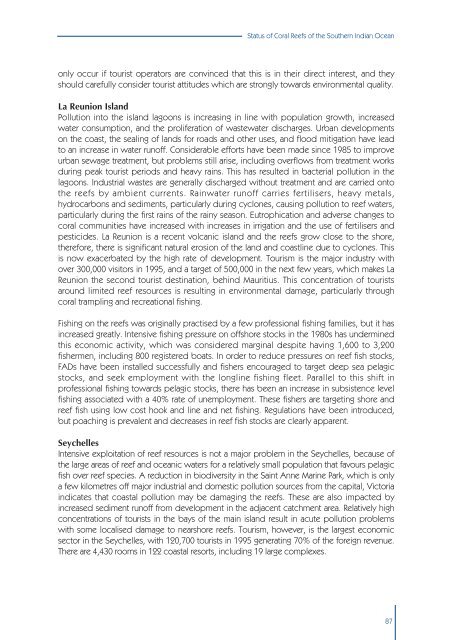Status of Coral Reefs of the World 2000
Status of Coral Reefs of the World 2000.pdf
Status of Coral Reefs of the World 2000.pdf
- No tags were found...
Create successful ePaper yourself
Turn your PDF publications into a flip-book with our unique Google optimized e-Paper software.
<strong>Status</strong> <strong>of</strong> <strong>Coral</strong> <strong>Reefs</strong> <strong>of</strong> <strong>the</strong> Sou<strong>the</strong>rn Indian Ocean<br />
only occur if tourist operators are convinced that this is in <strong>the</strong>ir direct interest, and <strong>the</strong>y<br />
should carefully consider tourist attitudes which are strongly towards environmental quality.<br />
La Reunion Island<br />
Pollution into <strong>the</strong> island lagoons is increasing in line with population growth, increased<br />
water consumption, and <strong>the</strong> proliferation <strong>of</strong> wastewater discharges. Urban developments<br />
on <strong>the</strong> coast, <strong>the</strong> sealing <strong>of</strong> lands for roads and o<strong>the</strong>r uses, and flood mitigation have lead<br />
to an increase in water run<strong>of</strong>f. Considerable efforts have been made since 1985 to improve<br />
urban sewage treatment, but problems still arise, including overflows from treatment works<br />
during peak tourist periods and heavy rains. This has resulted in bacterial pollution in <strong>the</strong><br />
lagoons. Industrial wastes are generally discharged without treatment and are carried onto<br />
<strong>the</strong> reefs by ambient currents. Rainwater run<strong>of</strong>f carries fertilisers, heavy metals,<br />
hydrocarbons and sediments, particularly during cyclones, causing pollution to reef waters,<br />
particularly during <strong>the</strong> first rains <strong>of</strong> <strong>the</strong> rainy season. Eutrophication and adverse changes to<br />
coral communities have increased with increases in irrigation and <strong>the</strong> use <strong>of</strong> fertilisers and<br />
pesticides. La Reunion is a recent volcanic island and <strong>the</strong> reefs grow close to <strong>the</strong> shore,<br />
<strong>the</strong>refore, <strong>the</strong>re is significant natural erosion <strong>of</strong> <strong>the</strong> land and coastline due to cyclones. This<br />
is now exacerbated by <strong>the</strong> high rate <strong>of</strong> development. Tourism is <strong>the</strong> major industry with<br />
over 300,000 visitors in 1995, and a target <strong>of</strong> 500,000 in <strong>the</strong> next few years, which makes La<br />
Reunion <strong>the</strong> second tourist destination, behind Mauritius. This concentration <strong>of</strong> tourists<br />
around limited reef resources is resulting in environmental damage, particularly through<br />
coral trampling and recreational fishing.<br />
Fishing on <strong>the</strong> reefs was originally practised by a few pr<strong>of</strong>essional fishing families, but it has<br />
increased greatly. Intensive fishing pressure on <strong>of</strong>fshore stocks in <strong>the</strong> 1980s has undermined<br />
this economic activity, which was considered marginal despite having 1,600 to 3,200<br />
fishermen, including 800 registered boats. In order to reduce pressures on reef fish stocks,<br />
FADs have been installed successfully and fishers encouraged to target deep sea pelagic<br />
stocks, and seek employment with <strong>the</strong> longline fishing fleet. Parallel to this shift in<br />
pr<strong>of</strong>essional fishing towards pelagic stocks, <strong>the</strong>re has been an increase in subsistence level<br />
fishing associated with a 40% rate <strong>of</strong> unemployment. These fishers are targeting shore and<br />
reef fish using low cost hook and line and net fishing. Regulations have been introduced,<br />
but poaching is prevalent and decreases in reef fish stocks are clearly apparent.<br />
Seychelles<br />
Intensive exploitation <strong>of</strong> reef resources is not a major problem in <strong>the</strong> Seychelles, because <strong>of</strong><br />
<strong>the</strong> large areas <strong>of</strong> reef and oceanic waters for a relatively small population that favours pelagic<br />
fish over reef species. A reduction in biodiversity in <strong>the</strong> Saint Anne Marine Park, which is only<br />
a few kilometres <strong>of</strong>f major industrial and domestic pollution sources from <strong>the</strong> capital, Victoria<br />
indicates that coastal pollution may be damaging <strong>the</strong> reefs. These are also impacted by<br />
increased sediment run<strong>of</strong>f from development in <strong>the</strong> adjacent catchment area. Relatively high<br />
concentrations <strong>of</strong> tourists in <strong>the</strong> bays <strong>of</strong> <strong>the</strong> main island result in acute pollution problems<br />
with some localised damage to nearshore reefs. Tourism, however, is <strong>the</strong> largest economic<br />
sector in <strong>the</strong> Seychelles, with 120,700 tourists in 1995 generating 70% <strong>of</strong> <strong>the</strong> foreign revenue.<br />
There are 4,430 rooms in 122 coastal resorts, including 19 large complexes.<br />
87
















